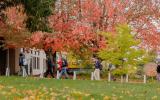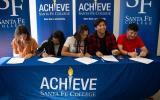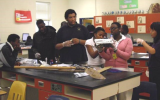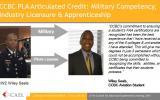College Readiness

The Seattle Promise Initiative, a pioneering program launched by the City of Seattle, aims to ensure that all public high school graduates in Seattle have access to higher education without the financial burden of tuition. An innovative component of this initiative is the Path to UW program, a collaboration between the Seattle Department of Education and Early Learning, Seattle Colleges, and University of Washington (UW). The program provides targeted support to Seattle Promise students as they transfer from community colleges to one of the most competitive universities in the nation....
Tags:

In a new spin on the challenge of meeting students where they are, Santa Fe College is serving one student a time, at scale. The SF Achieve initiative offers a unique take on a Promise Program by providing not just financial help, but direct college coaching and mentoring to students in their high schools. College specialists, embedded at local schools everyday throughout the school year, meet with students regularly, get to know them, and help them understand how a college education can serve as a launching pad for their goals and dreams. SF Achieve is literally meeting students where they...
Tags:

Community colleges are uniquely situated to address the nation’s need for a highly innovative, adaptable, and skilled workforce. At the federal and state levels, funding is available for design and delivery of workforce-building programs combining academic excellence, technical training, and practical experience.
Santa Fe College (SF) in Gainesville, Florida, has received a state grant to create a STEM-focused charter high school. The charter school will provide students with the tools needed to be successful in the 21st century workforce. SF’s vision is to ensure that each charter school...

Research suggests that student success, or first-year experience, classes are beneficial to new college students. A 2013 study by the Community College Research Center showed initial gains in credits earned and first-year retention (Karp and Stacey, 2013), although the same report found mixed results for long-term gains. Klinkenberg (2013) found higher rates of academic progress and persistence for students who completed a first-year experience course compared with those who did not enroll or did not successfully complete the course. A study at a Tennessee community college found higher fall-...

Researchers define a first-generation student as the first member of a family to attend college (Chen, 2005; Ishitani, 2006; Redford & Mulvaney Hoyer, 2017). In the U.S., these students are more likely to be African American or Hispanic (Chen, 2005), come from a lower socioeconomic status (Jenkins, Miyazaki, & Janosik, 2009; Redford & Mulvaney Hoyer, 2017), and have a higher rate of attrition at the collegiate level than their counterparts (Chen, 2005; Lohfink & Paulsen, 2005; Nuñez & Cuccaro-Alamin, 1998). Students who are first-generation as well as low-income are at a...

As part of the reaffirmation process of the Southern Association of Colleges and Schools Commission on Colleges, Wake Technical Community College launched a Quality Enhancement Plan (QEP) initiative based on best practices in eLearning. The goal of the eLearning Preparedness Initiative across the College (EPIC) is to remove learning barriers and better support online student learning, persistence, and success. A broad cross-functional and multidisciplinary team of faculty and staff developed and implemented eLearning Quality Standards, an online student orientation, and a faculty...

To address the representation gap in the sciences, a partnership of institutions implemented two different early college/dual enrollment courses for high school students as part of a larger project. One program was a concurrent (in-school) enrollment program, and the other was a summer residential program. Each program ran for five years, and all of them successfully prepared students for college STEM. Many students entered STEM programs in college, and 80 percent of them are still there today.
The Larger Project
The Minority Student Pipeline Math and Science Partnership—(MSP)2—was a joint...

Nearly 30 percent of high school juniors and seniors in Colorado participated in concurrent enrollment, ASCENT (Accelerating Students through Concurrent ENrollmenT), or other dual-enrollment programs during the 2014-2015 academic year.
Arapahoe Community College (ACC) served more students (3,614) than any other two-year institution in the state during that time. ACC’s concurrent enrollment program is designed for high school students looking for a challenging academic experience while simultaneously earning high school and college credit.
“Concurrent enrollment is a great way for students to...

The Community College of Baltimore County (CCBC), Maryland, is one of 20 community colleges nationally selected by the American Association of Community Colleges (AACC) to participate in the Right Signals Initiative designed “to identify and develop a national model for recognizable credentialing.”
According to the AACC announcement release,
The purpose of the Right Signals Initiative is to demonstrate a new credentialing model that recognizes multiple quality credentials to send “the right signals” to employers, students, and colleges about the meaning of these credentials. Key credentials...

In the fall of 2009, the first cohort of more than 100 ninth-grade students were admitted into Early College High School at Midland College (ECHS@MC). The school focuses primarily on serving first-generation college students, those with a low socioeconomic status, and/or those whose ethnicities are underrepresented at the college level.
Today, Midland College (MC) and the Midland Independent School District (MISD) have recognized three cohorts of graduates from the successful program. Over 85 percent of those students received associate degrees from Midland College at the same time they...
December
2015
The Maricopa Community Colleges has announced a new program that will help children who are aging out of the foster care system to get into and complete college. The Bridging Success Initiative, funded by the Nina Mason Pulliam Charitable Trust, was introduced at an event with partners from across the Valley.
The initiative advisory board has representatives from Arizona State University (ASU), Children's Action Alliance, Arizona's Children Association, Arizona Friends of Foster Care, College Success Arizona, College Depot, Florence Crittendon, and the Arizona Department of Child Safety.
The...
Tags:
July
2014
There's a little-known crisis occurring across the nation; a problem not many are aware of or would expect. Unless you're an educator. Specifically, a college educator facing a new class of freshmen. Because, it turns out that 66 percent (Complete College America, 2011), or about two-thirds, of your students, all of them recent high school graduates, are not going to be ready for what you are about to teach them.
What does this mean? It means that those students, instead of jumping feet first into freshman year, will spend extra hours and dollars taking remedial courses in math and English...
Tags:
June
2014
This year's Kid's Vision for Life See to Succeed event at San Jacinto College impacted approximately 1,133 school children from the Pasadena Independent School District (PISD).
Out of those who visited the college for free eye examinations, 96 percent were issued eye glasses, and 154 received medical referrals for further eye care treatment. This is See to Succeed's third year in delivering free eye glasses to PISD children in need.
"The beauty of this partnership is that our students are able to receive the tools they need to become successful," said Renea Ivy, associate superintendent of...
May
2014
Step UP is a grassroots program that evolved from the 25 member, cross-functional Developmental Education Committee that, in 2003, sought to create a program to improve the success and retention of developmental education students. The objective was to design a program at Howard Community College (HCC) that would provide positive support and encouragement to students as they make the often difficult transition and adjustment to college. After researching programs and interviewing students, a model for Step UP was created.
The program was piloted with five coaches and students in spring 2005....
2010
This guide is a product of the League's Significant Discussions Project, and was created to facilitate discussions between secondary and postsecondary faculty and administrators, and business, industry, and community partners. The Significant Discussions guide is a comprehensive set of tools to assist these partners in their collaborative work to better align curriculum across institutions, thus easing student transitions from high school to community college and university transfer. The guide is based on effective practices in place at nine participating sites and promising practices...










